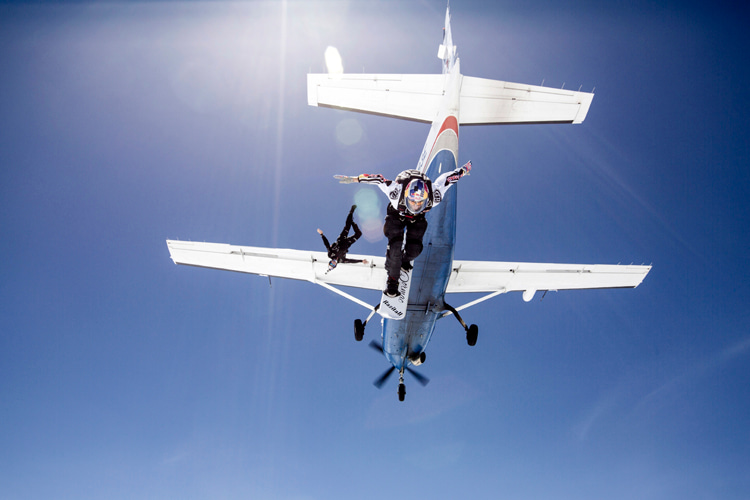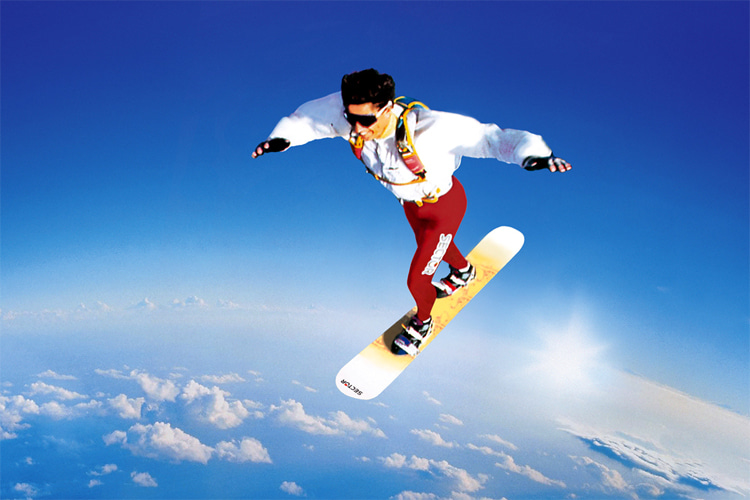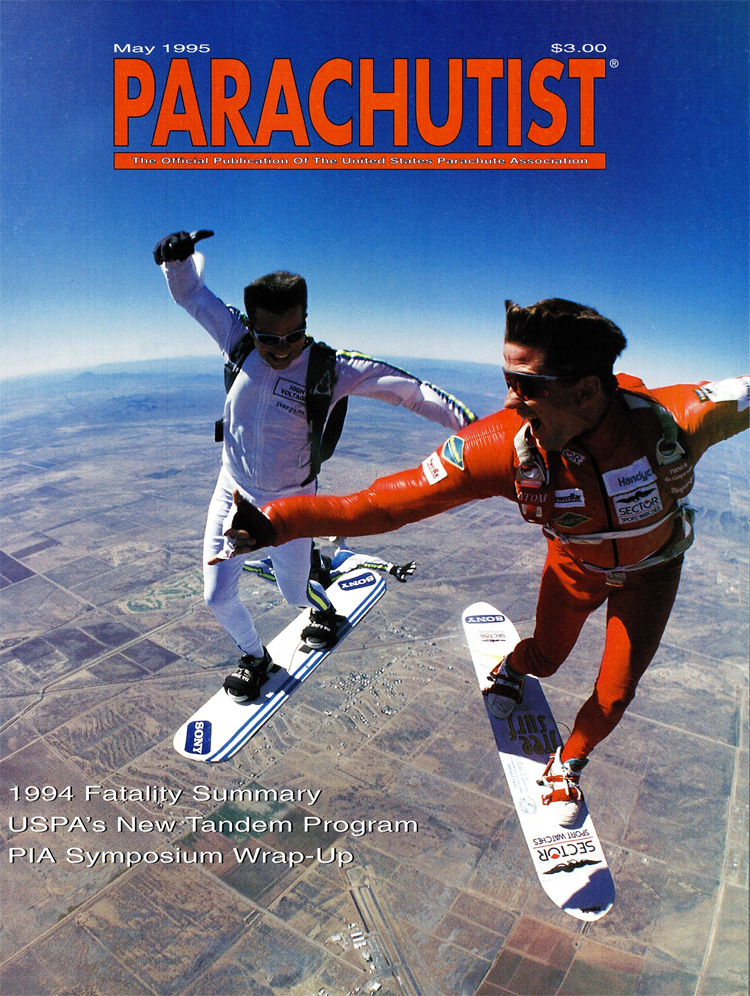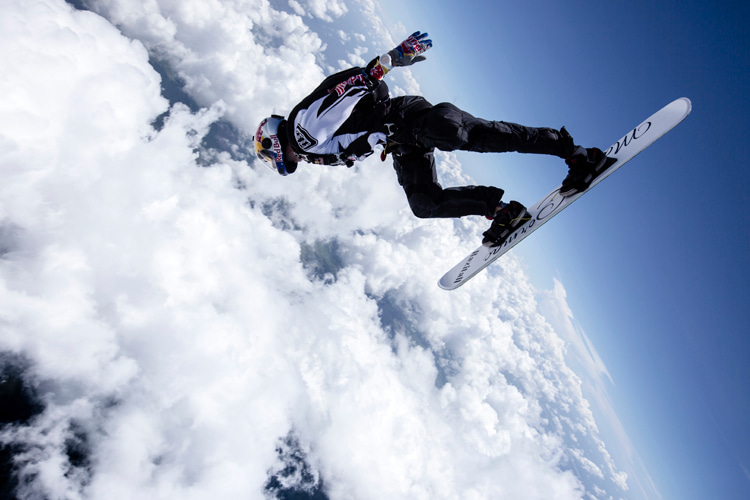Sky surfing is an extreme sport that involves riding on a specially designed board while performing aerobatic tricks in the sky during a freefall.
The rider attaches the board to their feet to control speed and direction during the descent before deploying a parachute.
It is considered one of the most exciting and dangerous skydiving disciplines.
Interestingly, there's an illusion to it.
To the ordinary observer, it looks like they're moving their hips and legs as if riding a surfboard on the relative wind.
When filmed, the free fall is not very clear, giving the impression that they are floating.
However, skysurfers use a great deal of arm and upper body strength to maintain a stable fall with the board under their feet.
Moreover, their actual speed is similar to a freefalling skydiver.
Interestingly, sky surfing is considered a team sport comprised of the skysurfer and the camera flyer carrying all sorts of shooting cameras.
Competitively speaking, the World Skysurfing Championships were held in the 1990s and early 2000s, with participants from around the world competing for top honors.
The X Games also featured sky surfing from 1995 to 2000, but the sport was eventually dropped due to safety concerns.
Freeflying became more popular, replacing sky surfing as the new hip alternative to freestyle.

Equipment
Sky surfing requires special equipment.
In addition to the typical skydiving gear, which includes goggles, an altimeter, and a parachute, a skysurfer needs a particular board, boots, bindings, and a helmet.
The board is usually made of fiberglass or carbon fiber and is designed to be lightweight and durable.
There are several sizes available, and almost all resemble snowboards and skateboards.
First-timers start on a beginner board (about 36") before progressing to an intermediate board (about 48") and to an advanced board (about 60").
The boots are designed to fit securely into the bindings attached to the board.
The helmet is essential for protecting the skysurfer's head during the descent and landing on the drop zone.
How It Works
Sky surfing involves jumping out of an aircraft at an altitude of 15,000 to 10,000 feet (4,572 to 3,048 meters).
It requires a lot of practice and certainly over 250 skydives to be able to hold a stable sit and a stable stand and over 500 to become a seasoned rider.
Once you get a few hundred simple jumps, feel prepared for handling emergencies, and are competent at head-up vertical flight, you may be ready to try sky surfing at its full potential.
Once in freefall, skysurfers can perform aerial surf-style maneuvers, including spins, flips, and rolls.
They can also use the board to control their speed and direction during the descent.
To stay stable while skydiving, it's better to stand straight up on the board. This is also the neutral position needed to deploy the main parachute.
Skysurfing also allows for more advanced aerobatic maneuvers like loops and helicopter spins.
However, since some of these moves involve high G forces, some skysurfers wrap ace bandages tightly up their arms to prevent blood from pooling at the end of their limbs.
Despite this bandaging technique, many techniques can still be extremely painful.
They may cause temporary paralysis of the fingers and subconjunctival bleeding (a broken blood vessel in the eye).
On a single jump, riders need to be able to do controlled left and right 360s in a sit, controlled left and right 360s in a stand, and front and back rolls in a stand.
The skysurfer must be qualified in emergency procedures and a very competent canopy pilot - basic canopy piloting, not swooping - and should jump a non-elliptical/non-high performance canopy.
Once riders reach the minimum altitude (2,500-4,000 feet or 762-1,220 meters), they release their parachute.
The goal is to land safely on the ground, ideally with a smooth and controlled touchdown.
As with any skydiving discipline, you should seek an experienced instructor to get into sky surfing.
British Skydiving developed an operations manual and guidelines for certifying skysurfers.
Its training programs ensure participants can learn, progress, and compete safely by mitigating all risks involved in this outdoor activity.
Remember that, as a skysurfer, each session has your life on the line.

A Brief History of Sky Surfing
The roots of sky surfing, also called sky boarding and skysurfing, go back to 1980 when some skydivers decided to try using Styrofoam boogie boards during their jumps in California.
They would lie flat on the board in free fall and hold onto the side rails. These daredevils referred to this activity as "air surfing."
The first to make it what it is today were French skydivers Jean-Pascal Oron and Dominique Jacquet in 1986.
One year later, for the movie "Hibernator," their fellow countryman Joël Cruciani did something new.
Instead of a special board, he used a regular-sized wave surfboard with snowboard-style boot bindings to make his freefall jumps.
The seeds for a new extreme sport had been planted.
1998
Laurent Bouquet, another French skydiver, used a skateboard-sized board attached to his feet during jumps.
Patrick de Gayardon, often considered the father of modern sky surfing, saw Bouquet using the small board and decided to start using it as well.
The discipline was developing fast.
1989
Laurent Bouquet performed a real-life version of the "Silver Surfer" comic book character for Thierry Donard's "Pushing the Limits."
Meanwhile, De Gayardon improved the equipment by creating a soft binding and cutaway system.
This system allowed the rider to release the board quickly and easily in an emergency.
1990
Patrick de Gayardon produced a segment for the French network television sports program "Traveling 2" called "Sky Surfer."
It showcased the first-ever tandem sky surfing stunt by Patrick and New Zealand rider Wendy Smith.
Bouquet, de Gayardon, Bruno Gouvy, Eric Fradet, Phillipe Vallaud, and Peter Schäfer all started experimenting with standing on boards while in free fall in Gap, France.
De Gayardon and Gouvy performed the first double skysurf for a Japanese TV commercial.
1991
By 1991, Patrick de Gayardon, Patrick Passe, and Didier La Fond created a Reebok skysurf commercial using a special board made of carbon fiber.
This commercial, called "Life is Short, Play Hard," introduced the idea of sky surfing to the American public.
Then, with the famous Coca-Cola sky surfing commercial filmed over Broken Hill, Ray Palmer became the first Australian skysurfer to be recognized.
Also, for Donard's "Pushing the Limits," Laurent Bouquet, Eric Fradet, and Peter Schäfer accomplished the first triple skysurf over Mont Blanc in France.
1992
Sky surfing was officially recognized as a sport by the Fédération Française de Parachutisme (FFP).
Jerry Loftis, an American skysurfer, established Surflite, the first company solely dedicated to creating skyboards.
In the same year, the first competitive sky surfing demonstration took place during the third annual World Freestyle Federation (WFF) World Championships in Eloy, Arizona.
Two teams performed as part of the freestyle event.
1993
In 1993, a grassroots sky surfing open competition was held by Skydive Arizona.
Eight teams, including the US team of Rob Harris and Joe Jennings, participated alongside de Gayardon and Fradet.
The WFF also established the initial rules for competitive sky surfing.
The first Skysurfing World Championships took place in Empuriabrava, Spain, as part of the WFF annual event.
The competition had separate divisions for advanced and intermediate riders - De Gayardon and Gus Wing became the first-ever world champion sky surfing team.
1994
Some of the most famous skysurfers, including De Gayardon, Fradet, Schäfer, and Pal Bergen, performed as part of the opening ceremonies for the Winter Olympics in Lillehammer, Norway.
Sky surfing competitions continued to grow in popularity and were held in several spots, including France, California, Illinois, and Belgium.
The second annual men's and the first women's Skysurfing World Championships were held in Arizona and were sponsored by Sony Handycam.
Harris and Jennings won the men's division, dethroning the pioneer of sky surfing, De Gayardon.
Amy Baylie-Haass became the first woman skysurfer to appear in a TV commercial for Sony Handycam.
De Gayardon, Fradet, and Harris made history again by performing the first triple sequential skysurf over Hawaii, filmed for the French TV series "Traveling 4".
1995
At the first ESPN Extreme Games in Newport, RI, ten sky surfing teams competed for a shared prize of $20,000.
Both men and women participated in the contest, and live air-to-ground transmitters were used to broadcast the action on a large TV screen at the landing zone for the audience to see.
Skysports International (SSI) was created and later renamed SkySportif.
It was established as the governing and organizing body for professional-level sky surfing and worked with events like the X Games.
On December 14, 1995, Rob Harris, a highly regarded Los Angeles club DJ, passed away in British Columbia while working on a non-skysurfing, skydiving stunt for a Mountain Dew commercial titled "007".
Harris was the first American to win a sky surfing world championship and the first X Games sky surfing gold medalist.
His teammate Joe Jennings was filming the stunt at the time of the accident.

1996
A new pro tour for sport parachuting was announced to qualify skysurfers for the annual ESPN X Games.
Troy Hartman and Vic Pappadato won the first tour.
At the same tour venues, a new three-member discipline called free-flying debuted as a "demonstration sport."
1998
Sadly, on April 13, 1998, Patrick de Gayardon, the French skydiver regarded as the father of sky surfing, died in a wingsuit testing accident at his drop zone in Hawaii.
The cause was determined to be a self-induced rigging problem.
Later that year, on May 10, Vic Pappadato, who won the X Games championship as a camera flyer for skysurfer Troy Hartman, died in a canopy collision while filming a formation skydive.
On August 14, Jerry Loftis, the American sky surfing pioneer and the founder of Surflite, passed away in Quincy, IL, after failing to deploy his reserve on time due to a canopy malfunction.
Valery Rozov lost his camera flyer, Alexi Krishtopa, on a jump during training or competition.
Later, he found a new teammate, Clif Burch, just in time for the X Games, and they won gold. They repeated their success in 2000, winning a silver medal.
2001
ESPN decided to stop featuring sky surfing in the X Games because not enough people were interested in watching it, which made it hard to get sponsors.
As a result, SkySportif International also shut down.
SSI organized and regulated the professional sky surfing level and helped work with events like the X Games.
Now, sky surfing is mainly controlled by national organizations that govern parachuting competitions.
Tanya Garcia-O'Brien did really well in the women's division of the Fédération Aéronautique Internationale (FAI) World Air Games, scoring more points than the men.
